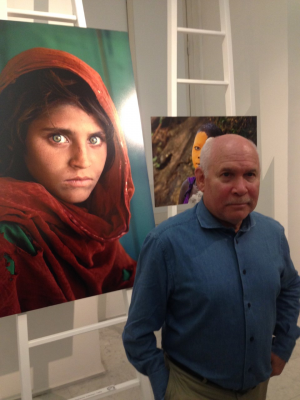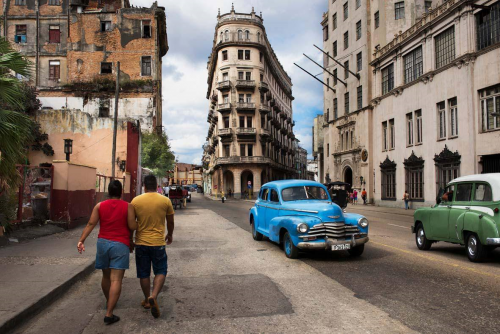McCurry comes to Naples: Cuba photograph left at home

NAPLES -- Famous American photographer Steve McCurry has come to Naples for an exceptional event entitled “Senza confini” (Without Borders), held at PAN – Palace of Arts.
From Oct. 28 to Feb. 2, 2017, the world-renowned photojournalist native to Philadelphia will exhibit his show in the Parthenope city.
The man who has been touching the world with breath-taking images since the 70s will be in the Naples spotlight for the last of his three appointments held in Italy this year. The show will include some of his most famous works and some recent inedited photographs.
In a self-established itinerary around the exhibit, the exposed prints are a great retrospection of the last 40 years. Moving images overtake the observer with snapshots from different corners of the world in a bifacial installation surrounded by ladder elements that weave around the picture frames symbolically ‘reaching where man cannot’.
The global roster Magnum photographer’s controversial photograph “Havana Club -2014” Cuba, however, will not be on display in the Via dei Mille museum.
For some months now, the artist and his Cuban image have been the object of a lot of talk. It all started when Italian photographer Paolo Viglione noticed a shoddy mistake in a photo-edited picture exhibited in the Venaria Reale di Torino Show and reported it in his blog.
The Magnum member suddenly found himself at the centre of a controversy over possible image manipulation during post-production.
Accused of carelessly Photo-shopping, McCurry could only admit the obvious mistake, blaming bad procedures at his studio, and saw to it that the employee responsible for the superficial touch up was immediately dismissed.
Despite sources declaring the misleading picture would have been removed from the show (as it had on the Magnum website), counter orders arrived from show organizers to set the record straight. The picture would stay put and there would be no particular caption explaining choices made in post-production editing. The ‘non message’ would be clear: there is nothing to be defensive or embarrassed about concerning touch-ups.
Explaining the missing photograph in Naples, Art Director Peter Bottazzi states, “Wanting to concentrate on one theme here at PAN and forced to narrow down print numbers due to limited space, we didn’t include any images from Cuba in the 160 photos selected to represent ‘Without Borders.’”
Having used common software to touch-up photos, you can see that a traffic post in a photo depicting the Caribbean street scene is missing its bottom part. The piece reappears out of place further on the left of the picture, completely detached from the rest of the signal, mixed into a passer-by walking by on the sidewalk.
In “The Blog,” Viglione originally denounces the photo-reporter, saying that he was a bit careless in his use of Photoshop. He explains the probable clumsy error, stating that the software user forgot to get rid of the bottom part of the post because the flaw seemingly melts into the walking individual’s leg, so it’s hard to spot.
The website entry has created a long-term domino effect that has led people to post comments around the globe, both criticizing and defending the famous photographer.
While it appears the error commonly occurs when using Photoshop superficially, such sloppy touch-ups should not occur when one reaches a high professional level.
Although McCurry gives some plausible, and some not so plausible explanations, perhaps the real issue has little to do with Steve McCurry and more around the ethics of photography itself.
Technology today has given photographers a new role in picture execution. How can we possibly return to the classic image of big photo shooters, where the viewer gets to observe exactly what the reporter has seen through his lens at the time the picture was taken?
At what point is it okay to touch-up a picture? How much is considered too much, where you lose touch completely with the actual subject or scene photographed? When does it lose its precious subjective value?
McCurry readily defends new technology, “I believe it is legitimate to interfere, by acting on contrasts, in order to minimize a marginal detail that risks invading or distracting the viewer when you want to him to focus on a facial expression. Sometimes, even how you centre the picture to balance out the picture counts, buts it is not necessary to move the elements in the image. In the controversial picture, the post could easily have been darkened to appear less evident by working on the shades or contrasts,” asserts the photographer.
In a private conversation, McCurry’s curator in Italy, Biba Giacchetti, points out various images on PAN walls to the Italian Insider as reflections of the American icon’s talent and dedication to his work. Sharing her observations, she says, “Steve is amazing. Take a look at this photo from Jodhpur, India from 2007. It took hours and hours for him to capture the right moment. Only when he saw this boy running, with extreme energy, did he realize that was ‘it’. Steve spends all day taking pictures just waiting for that split second that captures a thousand words.”
Surely, however, Photoshop did not partake in his unquestionable and unmodified masterpiece “Afghan Girl” taken in 1984. While spectators admire one of the American photographer’s most famous images in the following months, the real woman, now 41 years old, has been arrested in Pakistan for corruption and falsification of documents. Symbol of an unfortunate population victim of war, it seems Sharbat Gula’s misfortune has never really left her.
When Steve McCurry and National Geographic found her in 2002, Gula had never seen the pictures of herself that had made her famous all over the world neither had she benefitted by them. Now, an apparent attempt to buy herself and her children greater privileges and more freedom in Pakistan has driven her to prison, risking deportation back to Afghanistan.
The American photographer gained his fame from the shot of the 12-year-old that was published on the cover of National Geographic in 1985 and on various Amnesty International publications. Steve McCurry has been in the forefront of state conflicts for the past four decades, concentrating his shots on suffering populations forced to flee their homelands. The scenes and faces of his subjects mark the consequences left by wars.
For information visit: www.mostrastevemccurry.it
fb



